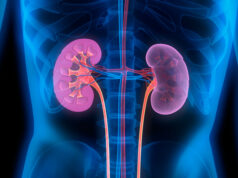The USNS Comfort navy hospital ship is docked at Pier 90. The military hospital ship’s 1,000 beds are expected to help overcrowded hospitals dealing with the city’s Covid-19 outbreak. Photo credit: Kena Betancur, Getty Images
With fast-growing numbers of critically ill patients, mask shortages and limited staff, healthcare workers across the U.S. have all seen the Covid-19 pandemic affect their practice. The fast-spreading virus has sickened more than 300,000 in the U.S. as of Saturday, and killed more than 8,400, according to data from Johns Hopkins University.
Hospitals in some states are still seeing relatively few cases, with weeks to prepare before they’re expected to see a surge of the disease. Others, such as New York and Louisiana, are nearing the apex of the crisis. New York had more than 113,000 cases on Saturday. Physicians there are warning their peers to prepare.
In Louisiana, where Mardi Gras revelers congregated in mid-February, the state is now reporting 12,500 cases. Other communities across the South and Midwest will likely see a surge of cases in the coming weeks.
MedCity News spoke with physicians across the country to see how they are preparing for Covid-19.
NORTH CAROLINA
In Charlotte, North Carolina, where Dr. David Callaway works as an emergency physician for Atrium Health, the emergency room has grown quiet. The hospital saw a decrease in volumes in the past two weeks, as more patients opt not to come in, out of fear of catching Covid-19.
“It’s a bit like when the tide goes out before a tsunami,” Callaway said. “You see an increase in ‘worried well’ coming to get tested for Covid-19. That starts to drop off. Then you see this peak of just really sick patients coming in. We’re not hitting that peak yet but we’re starting to see it pop up around the community.”
For his community, it’s still in the early stages of the outbreak. In North Carolina, there have been 2,400 confirmed Covid-19 cases, according to data from Johns Hopkins University. In Charlotte, there have been 600 cases and three deaths. The state issued a stay-at-home order last week.
But Callaway, who heads up crisis planning, has been preparing for this for much longer. It started at a meeting in February, when more information started to come out of China about the new virus.
“There was a broad feeling that this was something different,” he said. “We started to lay out generally what we thought some of our priorities would be. Frankly, watching how we approached the problem made me know that we needed to individually at the local levels be aggressive about our planning.”
Atrium Health established a task force three weeks ago, and began to ramp up its capabilities to deliver virtual care visits and save up redundant levels of personal protective equipment. This was well before North Carolina had its first case, Callaway said.
“People could say this is a huge financial investment,” he said. “It allowed us to really hit the ground moving when we saw cases pop up on the East Coast.”
Atrium has more than 40 hospitals and 60,000 employees across three states. The hospital has set up screening sites outside of its hospitals to determine if its patients are at risk of Covid-19 or not. The hospital has designated emergency areas and supplies for Covid-19 patients, in order to eliminate crossover.
Callaway, a former expeditionary medicine physician with the U.S. Marine Corps, has been working in crisis operations for 15 years. That typically means preparing for tornados, hurricanes, and other single events. With a public health crisis, such as infectious diseases, that response looks a little bit different.
“Right now, the techniques of borrowing from a local nonaffected area can’t be applied. The trick is, unlike a response to a single event, every decision we make has strategic implications for future healthcare,” he said. “I feel like we’re preparing as well as we can. We will always have gaps. We’ll always need more equipment. We’re creatively solving problems.”
Callaway spends 20 hours a day in the ER either working or planning. He likened it to fighting a war on home turf. For him, and many of his peers, the biggest stressor is that this is personal.
“We deal with life and death, we deal with crisis a lot,” he said. “The family piece is wearing on people a lot.”
Callaway has two daughters, ages 4 and 6. His wife is also a physician.
“The fact that this will probably go on for months… I still want to be able to see my kids and keep them safe,” he said. “The biggest thing that weighs on my mind at 4 a.m. is making sure my girls know I’m doing something good for them.”

A view of Honey From the Rock Cafe in Augusta Georgia as they are temporarily closed due to the Covid-19 outbreak. Photo credit: Kevin C. Cox, Getty Images
SOUTH CAROLINA
Avi Bhar and his wife, both physicians, are treating patients in two different communities that are facing the Covid-19 pandemic. Bhar commutes daily to work as a critical care physician at a hospital in South Carolina. He also has his own sleep and pulmonary telemedicine practice, Sliiip, where he has been seeing some Covid-19 patients, though in less critical condition. His wife works as a hospitalist in Macon, Georgia, where they both live.
Bhar said both of the communities they serve have seen an uptick in the number of patients. South Carolina has 1,700 confirmed cases and 34 deaths, and Georgia has 5,967 cases and 201 deaths.
He first began seeing cases related to the pandemic two weeks ago, when he started a 17-night run working in the ICU.
“I am doing ok. This is what I was trained for, yet I am nervous about getting sick and worried about spreading it to other patients who do not have it,” Bhar wrote in an email. “My wife is covering Covid patients at her hospital and I’m concerned about her health too. We have to work in separate towns which increases our emotional stress, but it may work out best as we are less likely to contaminate each other.”
One of Bhar’s biggest concerns is the possibility of asymptomatic carriers with the virus. The hospital where he is working has a dedicated ICU for Covid-19 patients, mostly occupied by patients under suspicion with high oxygen needs. This can help the hospital focus some of its resources. But on the general floors, he said practitioners might be a bit more lax in using protective equipment, due to lack of availability and the perception that their patients don’t have Covid-19. Some patients have been showing symptoms after admission.
“Protocols are written to address pertinent and common issues. These generally work well for (patients under investigation) or Covid-positive patients, my concern is that in a pandemic, we have many asymptomatic patients or healthcare workers – like a ticking time bomb,” he wrote. “Even with a Covid-dedicated unit, all healthcare workers need to be vigilant. The counter argument is that this may lead to unnecessary consumption of PPE.”
Another concern is the turnaround time to get tests. In most states, it still takes multiple days to get a result. Being able to rule out patients faster would be helpful in freeing up beds in the Covid-19 dedicated ICU for those who are waiting for results, Bhar said.
He also urged states to act together to implement social-distancing measure whenever possible. While Georgia implemented a stay-at-home order on Friday, South Carolina has not yet issued one.
“I need state governments to take this seriously and to act in unison,” he wrote. “We are surviving now in SC (in terms of workload), though NY (and some other areas) are barely treading water. If states play ostrich with this virus, we will all encounter a second or third spike of cases into the year.”

A staff member pushes a patient in a wheelchair at St. Barnabas Hospital in New York City. Photo credit: Misha Friedman, Getty Images
NEW YORK
New York City has been the hardest hit region in the U.S., with more than 60,000 cases and 2,254 deaths as of Saturday. Hospitals across the city are preparing for the most challenging week, with New York City expected to reach peak infection rates within six to seven days.
In the Bronx, leadership at SBH Health System are particularly concerned, given that many people in their community have other health conditions and limited space to self-quarantine.
“I’m really nervous for the community. These are people with tough lives and little means,” CMO Dr. Eric Appelbaum said in a phone interview. “How many people are living in a house with their grandma and parents and one bathroom? Where are they going to isolate? Luckily, most of (my patients) are doing pretty well.”
SBH Health System may be relatively small for New York, but it still serves a substantial number of patients. The 400-bed hospital sees at least 85,000 visits per year. Most of its patients are covered through Medicaid.
It was Friday the 13th when the hospital saw its first Covid-19 case. It had canceled all elective procedures a week prior, a move that Appelbaum said saved a lot of people from getting sick. By March 27th, the hospital was up to 150 cases. Right now, the number of emergency department visits is down, but the acuity is much higher.
Appelbaum said he had been charting the number of cases the hospital saw going up. First it was one. Then three. Then 5, 11, 14…
“It seemed to double for a while. I was shocked to see those numbers and how quickly they moved,” CEO David Perlstein said. “We’ve started to see quite a few expirations as well. That’s the sad part of this.”
Appelbaum began preparing for Covid-19 long before the hospital saw its first case. He said he had been following it even before New Year’s Day. After hearing about one case of this strange virus, they began to preserve N95 masks.
“Then, it turned out in January, the price of surgical masks went through the roof,” he said.
At this point, Appelbaum said the hospital is at the point where everyone can get an N95 mask. They have the technology to reuse them if needed, but healthcare workers on the front lines get new masks. One of the challenges is that it’s not just doctors and nurses who need masks; it’s also the medical assistants, registrars, security guards and food service people.
On top of PPE, Appelbaum said he wishes he had thought of a few other things that are now short in supply. Ancillary equipment, such as IV pumps, are harder to get. Some medications, such as certain sedatives used when intubating patients, are running in short supply, but alternatives can be used.
“Eric sounded the alarm very early on. He recognized that this was going to be real,” Perlstein said. “When it hit, he had already gotten us ready. We had been putting away some PPE. It wasn’t enough; it has been much larger than we would have believed.”
The hospital has been adding more beds and gradually dedicating more space to fighting the virus. In the ICU, they’ve doubled up beds to make more space. The endoscopy recovery room is now used for Covid-19 patients, as is the trauma center. SBH Health also repurposed a slow inpatient pediatrics unit for Covid-19.
“We’ve branched out. But eventually, unfortunately, we will run out of space,” Perlstein said. “If I start putting beds in the cafeteria, I don’t know how much better equipped I am.”
Normally, SBH Health would have 50 ventilators on hand. The hospital secured 35 more. 60 of them were in use last week, mostly occupied by Covid-19 patients.
Perlstein said it’s hard to know how many cases the city will see in the coming weeks. 100,000 would be manageable. 500,000 — not so much.
The hospital has formed a special ethics committee to work through how ventilators would be distributed if it runs out of capacity. The hospital has not had to use those guidelines, Appelbaum said, but “It makes you sick to your stomach.”
“The fact that I have the guidelines is really tough to think about,” he added.
Perlstein said he’s seen the virus manifest itself in other ways, too. His son’s restaurant was affected by layoffs. Individuals with severe mental health or substance abuse issues are not getting the care they need, and that’s starting to manifest itself in the streets.
“The city is changed. It is a very weird place,” he said. “It’s going to make its way across the states. The question is whether we’re ready for it.”

A view of an empty street in the French Quarter amid the Covid-19 pandemic on March 27 in New Orleans. Photo credit: Chris Graythen, Getty Images
LOUISIANA
Physicians in New Orleans are preparing for the next wave of Covid-19, as the number of cases in the region surged quickly in late March. The city had a total of 3,966 confirmed cases and 153 deaths as of Saturday, with Louisiana reporting more than 12,000 cases statewide.
At Ochsner Health, a 40-hospital system based in New Orleans, officials are quickly moving to bring in as many beds, doctors, and as much equipment as possible. During a Friday press conference, CEO Warner Thomas said they had 888 confirmed positive cases or patients under investigation.
“Total volumes are down from what we might see. The problem is the acuity, the number of people who need critical care, perhaps intubation, is dramatically up,” Chief Medical Officer Dr. Robert Hart said.
Ochsner opened 50 additional ICU beds in the last week, and plans to open 60 more in the next week. But beds alone aren’t enough. The hospital will also need more ventilators to care for the sickest patients, and more staff, both of which it is searching for feverishly.
Ochsner is bringing in 140 nurses from out of town to help. The hospital system will continue to seek out more nursing professionals and other staff to help.
“For physical space, we have some options. But getting staffing in is going to be crucial,” Hart said.
As for ventilators, both the hospital and state government are pushing to bring in as many as possible. The state is expected to receive 350 from the national stockpile.
Part of the challenge with Covid-19 is that patients need to stay on ventilators for an extended period of time. Rather than spending just three to four days in the ICU, patients are there for a dozen or more.
We are waiting for additional ventilators to help with expansion of our ICU beds in the next week,” Thomas said. “We did get some from the state in the past few days, which is helpful. We’re sourcing from everywhere. Every vendor we can find.”
When it comes to PPE, Ochsner still has some, and is working with local manufacturers to get more. For example, the health system began working with a local company to produce face shields. It’s also working with a local distillery to produce hand sanitizer and a clothing maker for surgical gowns. N95 masks, which play a valuable role in protecting physicians from the virus, require more complicated supply chains.
“With PPE, we’re staying a step ahead, but it’s getting harder and harder as this spreads across the country,” Hart said.
The health system has also started to process its own tests. At first, it had shipped them to a Mayo Clinic, but it is now able to run 1,000 tests per day in house. Thomas said the hospital would have access to some of Abbott’s rapid test kits, and might be able to use them in some of its emergency departments to quickly determine if patients are positive for Covid-19.
Ultimately, Thomas said the biggest piece of advice he would offer his colleagues is to prepare from a staffing perspective.
“Understand that staffing is the big issue,” he said. “Try to get ahead of that by identifying staff that work part time for you and ramping that up.”







